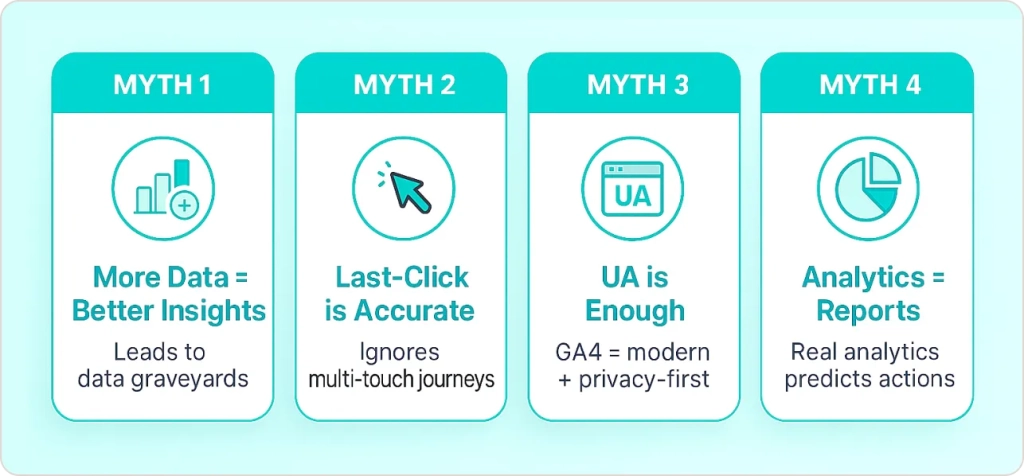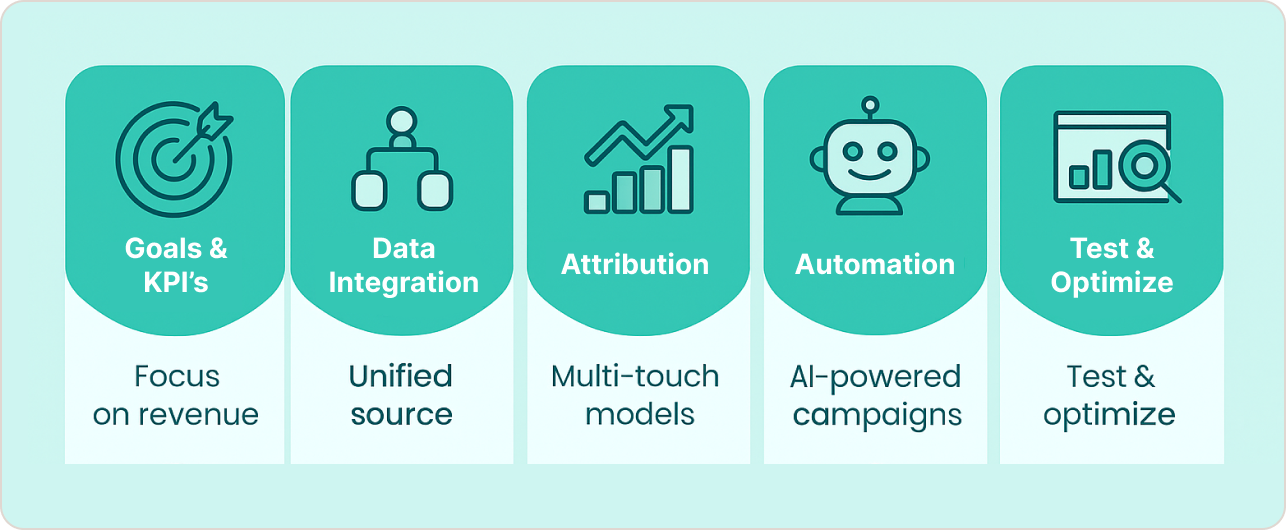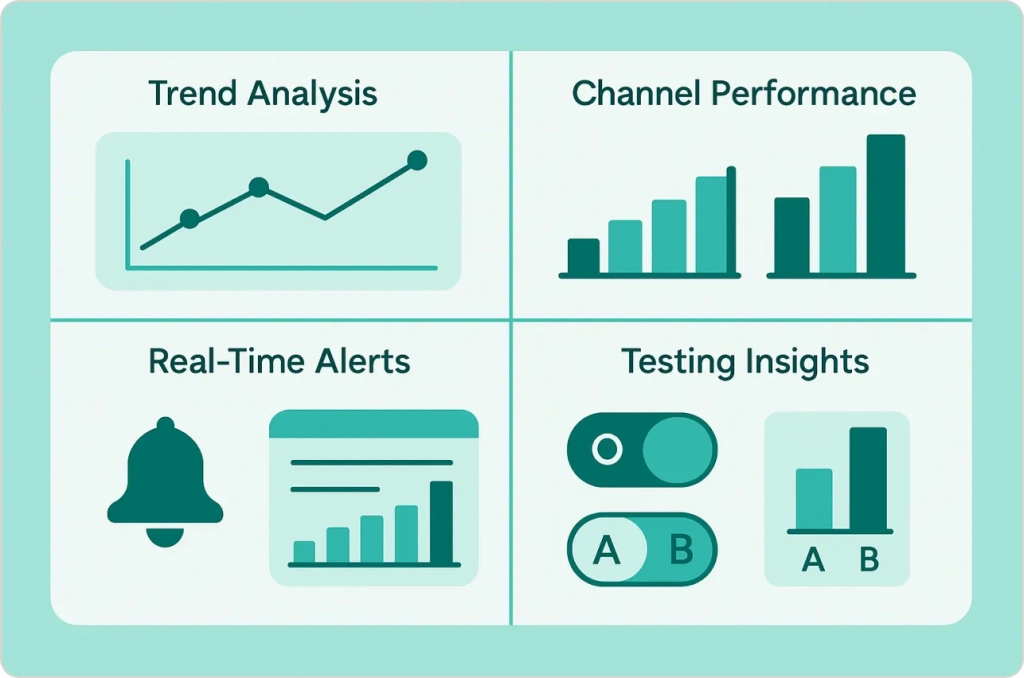Key Highlights:
- Set revenue-connected KPIs using historical data
- Eliminate data silos through unified platform integration
- Implement multi-touch attribution for accurate ROI measurement
- Deploy AI automation for real-time campaign optimization
- Transform insights into actionable business decisions
“Most businesses waste 60% of their marketing data potential through disconnected systems and unclear attribution models.”
Marketing executives consistently ask: “We’re collecting massive amounts of customer data, but how do we know if our marketing efforts are actually driving profitable growth?” The brutal truth: 87% of marketers report that data is their company’s most under-utilized asset.
In 2025, the gap between brands that use analytics effectively and those that don’t is wider than ever. Companies executing advanced marketing analytics techniques achieve 49% faster profit growth than competitors relying on intuition.
This framework provides marketing leaders with 5 battle-tested strategies that separate high-performing organizations from those drowning in spreadsheets. Unlike generic marketing advice, these tactics deliver specific, actionable guidance that transforms data into competitive advantage.
Marketing analytics strategy combines goal-setting, data integration, attribution modeling, automation tools, and visualization to optimize campaigns. Companies using these five strategies achieve 49% faster growth through data-driven decisions.
Understanding Marketing Analytics Strategy Foundations
What is marketing analytics? It’s the systematic measurement, management, and analysis of marketing performance to maximize effectiveness and optimize return on investment.
Why marketing analytics is important becomes clear when you consider that organizations utilizing sophisticated marketing analytics techniques report 49% faster profit growth than competitors.
Key Business Impact Areas:
- Complex customer journey navigation and attribution challenges
- Revenue growth acceleration through data-driven decisions
- Operational efficiency improvements across marketing channels
- Competitive advantage through sophisticated analytics capabilities
Modern marketing analytics strategy encompasses everything from basic campaign tracking to AI-powered predictive modeling. Current marketing analytics trends show that companies investing in comprehensive marketing analytics services consistently outperform competitors.
Understanding marketing analytics trends helps organizations stay ahead of evolving customer behavior patterns and privacy regulations. Leading marketing analytics services providers report that businesses following these trends achieve superior competitive positioning.
Components of Effective Marketing Analytics Strategy
Effective marketing analytics frameworks require three core elements for systematic performance optimization:
- Standardized measurement protocols for consistent data collection
- Integrated data platforms that eliminate information silos
- Sophisticated attribution modeling for accurate ROI calculation
Professional marketing analytics services help businesses implement these frameworks while addressing why marketing analytics is important for sustainable competitive advantage. Modern marketing analytics techniques enable real-time optimization and predictive modeling capabilities.
Top-tier marketing analytics services focus on staying ahead of emerging marketing analytics trends, including AI-powered personalization and privacy-first data collection methods that ensure long-term competitive positioning.
Where Most Businesses Get Marketing Analytics Wrong

Myth 1: More Data Equals Better Insights
Most organizations collect everything possible, creating data graveyards instead of actionable intelligence. The reality: 73% of marketers spend over 20 hours annually producing reports that stakeholders never engage with.
Myth 2: Last-Click Attribution Shows True Performance
Traditional attribution gives all credit to the final touchpoint, making businesses kill their best awareness channels. Smart marketers know that customer journeys span multiple touchpoints across weeks or months.
Myth 3: Universal Analytics is “Good Enough”
With UA officially discontinued, businesses clinging to outdated measurement miss critical cross-device insights and privacy-compliant tracking. GA4 isn’t just an upgrade—it’s a fundamental shift in how data is collected and analyzed.
Myth 4: Marketing Analytics is Just Reporting
Basic reporting tells you what happened. True marketing analytics strategy predicts what will happen and prescribes what actions to take next. Most teams mistake historical dashboards for strategic intelligence.
Five Essential Marketing Analytics Strategies for Growth

Strategy 1: Define Clear Goals & KPIs Using Existing Data
Establishing Foundation-Level Analytics Capabilities
Most marketing organizations begin with basic reporting capabilities but lack strategic goal alignment. Marketing teams spend excessive time on manual reporting rather than strategic optimization activities.
Common Foundation Problems:
- Disconnected data across multiple platforms
- Limited visibility beyond basic metrics
- Channel-specific data instead of customer journey insights
- Decision-making based on vanity metrics rather than business impact
Implementation Framework for Goal-Driven Analytics
Begin by analyzing existing customer data to understand current conversion rates, customer acquisition costs, and lifetime value patterns. For e-commerce businesses, this might reveal average order values of $85 with 2.8% conversion rates, enabling realistic goal setting like achieving 3.2% conversion within six months.
SaaS companies should focus on metrics directly connected to recurring revenue: trial-to-paid conversion rates, monthly recurring revenue growth, and customer churn patterns.
Industry-Specific KPI Framework
| Industry | Primary KPIs | Secondary Metrics |
|---|---|---|
| E-commerce | Conversion Rate, AOV, CLTV | Cart Abandonment, Traffic Sources |
| SaaS | MRR Growth, Churn Rate, Trial-to-Paid | Feature Adoption, Support Tickets |
| Healthcare | Patient Acquisition Cost, Appointment Completion | Referral Source ROI, Patient Satisfaction |
| Financial Services | Lead Quality Score, Application Completion | Cross-sell Success, Compliance Metrics |
| B2B Manufacturing | Sales Cycle Length, Territory Performance | Channel Partner ROI, Quote-to-Close |
The key involves selecting 3-5 primary KPIs directly connecting to revenue impact rather than tracking dozens of vanity metrics. Professional marketing analytics services help establish automated KPI tracking and regular reporting cadences that maintain team alignment on strategic objectives.
Successful marketing analytics services emphasize the importance of following current marketing analytics trends when selecting KPIs, ensuring measurements align with evolving customer behavior patterns and regulatory requirements.
Strategy 2: Consolidate & Integrate Data (Single Source of Truth)
Breaking Down Marketing Data Silos
Marketing teams consistently struggle with fragmented data across multiple platforms. Google Analytics data doesn’t match Facebook Ads reporting, CRM systems show different customer counts than email platforms, and website analytics can’t connect to offline sales data effectively.
Common Data Fragmentation Issues:
- Conflicting performance narratives across different marketing channels
- Manual data extraction and compilation consuming excessive time
- Impossible comprehensive customer journey analysis
- Decision-making based on incomplete or contradictory information
Advanced Integration Architecture Requirements
Successful marketing analytics strategy requires integrating data from all marketing channels into centralized platforms. This integration connects Google Analytics 4 with advertising platforms, CRM systems, email marketing tools, and any other customer touchpoints systematically.
Modern businesses implement this through marketing data warehouses or business intelligence platforms that automatically synchronize data across systems. This comprehensive approach demonstrates why marketing analytics is important for understanding true customer behavior patterns.
Technical Implementation Methodology
Start with critical data sources: website analytics, primary advertising channels, and CRM systems. Utilize APIs and automated connectors to aggregate data into central repositories.
Popular platforms include Google BigQuery, Microsoft Power BI, or specialized marketing analytics platforms. Many organizations achieve success using dedicated marketing analytics services specializing in data integration.
Modern marketing analytics trends emphasize automated integration capabilities, and forward-thinking marketing analytics services now offer AI-powered data synchronization that reduces manual errors while improving data quality and consistency across all platforms.
Real-World Integration Case Study
An e-commerce client integrated Shopify with Google Ads, Facebook Ads, email marketing, and customer service systems. Before integration, decision-making relied on incomplete data, making it impossible to understand why certain campaigns appeared successful in advertising platforms but failed to drive profitable sales.
After implementing unified tracking through advanced marketing analytics techniques, analysis revealed that Facebook ads generated high click-through rates but Google Ads delivered customers with 40% higher lifetime value. This insight enabled budget reallocation improving overall return on investment by 28% within three months.
Strategy 3: Use Advanced Attribution & Modeling (MMM, MTA)
Beyond Traditional Attribution Limitations
Traditional last-click attribution models assign complete conversion credit to final touchpoints, creating dramatically incomplete marketing effectiveness pictures. Understanding current marketing analytics trends helps businesses recognize that sophisticated attribution modeling has become essential for accurate performance measurement and budget optimization.
Multi-Touch Attribution Implementation
Multi-touch attribution (MTA) distributes conversion credit across all customer touchpoints based on actual influence in conversion processes. This advanced marketing analytics technique reveals which marketing activities work synergistically to drive results while optimizing entire customer journeys.
Key Attribution Benefits:
- Reveals true channel performance beyond final touchpoint
- Optimizes budget allocation across entire customer journey
- Identifies highest-value touchpoint combinations
- Enables sophisticated cross-channel campaign coordination
Marketing Mix Modeling for Strategic Planning
Marketing Mix Modeling (MMM) elevates attribution analysis to strategic levels, using statistical modeling to understand channel interactions and their influence on overall business performance. This sophisticated marketing analytics technique accounts for external factors including seasonality, competitive activity, and economic conditions.
MMM enables answering critical strategic questions like budget impact forecasting and growth attribution analysis. These advanced marketing analytics techniques enable organizations to understand why marketing analytics is important beyond basic campaign measurement.
Leading marketing analytics services now incorporate MMM capabilities as standard offerings, recognizing that current marketing analytics trends demand more sophisticated attribution modeling to compete effectively in privacy-first digital environments.
Advanced Attribution Technology Requirements
Implementation begins with proper cross-device tracking ensuring analytics setups can connect customer actions across multiple sessions and devices. More sophisticated attribution modeling requires specialized platforms or collaboration with experienced marketing analytics services providers.
A SaaS client implementing multi-touch attribution discovered that paid search campaigns appeared expensive based on last-click analysis but actually initiated customer journeys converting at significantly higher rates when combined with content marketing and email nurturing. This insight led to 45% increased paid search investment and 32% improved overall customer acquisition efficiency.
Predictive Attribution Capabilities
The most advanced attribution models use machine learning to predict future customer behavior and optimize budget allocation proactively. These sophisticated marketing analytics techniques analyze historical customer journey patterns to recommend optimal channel investment strategies.
Organizations implementing predictive attribution typically achieve 20-30% improvements in marketing efficiency within six months of deployment. This demonstrates why marketing analytics is important for competitive advantage and reflects current marketing analytics trends toward AI-powered optimization.
Sophisticated marketing analytics services increasingly offer predictive attribution as part of comprehensive packages, helping businesses stay ahead of emerging marketing analytics trends while maximizing return on analytics investments through automated optimization capabilities.
Strategy 4: Leverage the Right Tools & Automation
Essential Marketing Analytics Platform Architecture
The marketing analytics landscape includes hundreds of tools, but success requires selecting optimal combinations for specific organizational needs rather than attempting to utilize every available platform. Foundation typically includes Google Analytics 4 for web analytics, business intelligence platforms for data visualization, and marketing automation tools for campaign execution.
Google Analytics 4 Implementation
Proper GA4 setup goes far beyond basic tracking code installation. Configure enhanced ecommerce tracking, set up conversion goals that align with your business objectives, and implement custom dimensions that capture the data points most relevant to your marketing analytics strategy.
GA4 Setup Essentials:
- Enhanced ecommerce tracking for revenue attribution
- Custom conversion goals aligned with business objectives
- Cross-platform audience targeting integration with Google Ads
- Privacy-compliant data collection and processing
Many businesses miss critical opportunities by failing to connect GA4 with Google Ads for improved audience targeting and automated bidding optimization. For comprehensive setup guidance, review Google’s official GA4 implementation guide.
Marketing Automation and AI Integration
Modern marketing automation platforms utilize machine learning to optimize campaign timing, personalize content recommendations, and predict customer behavior patterns. These advanced marketing analytics techniques analyze customer data to determine optimal email send times, identify high-value prospects, and automatically adjust campaign targeting based on performance data.
AI-powered tools analyze customer behavior patterns to predict conversion likelihood, enabling sales teams to prioritize efforts while marketing teams create more targeted nurturing campaigns. This integration showcases what is marketing analytics capability in the age of artificial intelligence and automated decision-making.
Strategy 5: Visualize Insights & Act (Dashboards, Reports, Tests)

Transforming Data into Strategic Action
The ultimate objective of any marketing analytics strategy involves driving superior business decisions through clear, actionable insights. This requires transforming complex datasets into visual formats highlighting opportunities and enabling rapid decision-making processes.
Advanced Dashboard Design Principles
Effective marketing dashboards focus on trends, exceptions, and actionable metrics rather than overwhelming users with comprehensive data points. Design dashboards answering specific business questions like “Which campaigns are underperforming relative to targets?” or “What factors are driving recent customer acquisition cost increases?”
Dashboard Must-Haves:
- Trend analysis rather than static numbers
- Performance comparisons across marketing channels
- Automated alerts for significant metric changes
- Exception highlighting that requires immediate attention
Real-Time Monitoring and Alert Systems
Establish automated alerts for significant changes in key performance indicators. This enables rapid response to both opportunities and performance issues. Advanced monitoring systems can predict performance anomalies before they significantly impact campaign results.
Testing and Optimization Culture Development
The most successful marketing analytics strategy implementations combine measurement with systematic testing methodologies. Utilize A/B testing to validate hypotheses generated from analytics data while creating feedback loops that improve both testing methodology and analytics setup over time.
Industry-Specific Dashboard Applications
E-commerce dashboards emphasize conversion rates, average order values, and customer lifetime value trends. B2B companies prioritize lead quality metrics, sales cycle analysis, and account-based marketing performance indicators. Healthcare marketing organizations track patient acquisition costs, appointment scheduling efficiency, and referral source analysis.
Continuous Improvement Process Framework
Establish regular review cycles where teams analyze dashboard data, identify optimization opportunities, and plan testing initiatives. Monthly analytics reviews should focus on trend analysis and strategic implications while weekly reviews address tactical campaign adjustments.
Successful organizations create systematic processes that consistently act on insights to drive continuous improvement rather than simply monitoring performance passively.
Overcoming Common Implementation Challenges
Data Quality and Privacy Considerations
One of the most significant obstacles to successful marketing analytics strategy implementation involves inconsistent or poor-quality data. Establish data governance processes ensuring consistent naming conventions, proper tracking implementation, and regular data quality audits.
Common Data Quality Issues:
- Inconsistent naming conventions across platforms
- Duplicate customer records and incomplete profiles
- Missing tracking codes and broken analytics implementations
- Poor data synchronization between marketing tools
Modern marketing analytics techniques must account for privacy regulations including GDPR and CCPA. WordStream’s comprehensive marketing statistics provides detailed insights on privacy-compliant tracking methods.
Measuring Success and Future-Proofing
Analytics Performance and ROI Framework
Organizations should establish comprehensive success metrics for marketing analytics strategy implementation. Most organizations see positive ROI within 6-9 months of proper implementation.
Key Success Metrics:
- Reduction in manual reporting time (target: 60-70% decrease)
- Improvement in campaign performance and conversion rates
- Increase in data-driven decision making across teams
- Enhanced attribution accuracy and budget optimization
Emerging Technologies and Scalability
Stay informed about developments in AI-powered analytics, predictive modeling, and cross-platform measurement capabilities. Adobe’s 2025 marketing analytics research highlights how leading companies are building analytics capabilities for sustained growth.
Future-Ready Infrastructure Elements:
- Cloud-based solutions that scale with business growth
- AI-powered automation for real-time optimization
- Privacy-first data collection and processing methods
- Cross-device tracking and attribution capabilities
Conclusion
These five marketing analytics strategies create the foundation for sustained competitive advantage through data-driven optimization. Companies that treat analytics as a strategic capability rather than a reporting function consistently outperform competitors.
The investment in proper marketing analytics strategy pays dividends through improved campaign performance, reduced wasteful spending, and enhanced customer experiences. Whether implementing internally or partnering with specialized Marketing Analytics Solutions, success requires starting with clear objectives and building systematic processes that transform data into competitive advantages.





